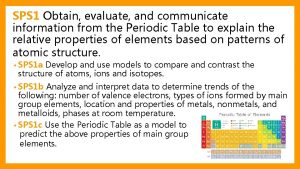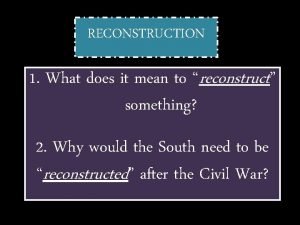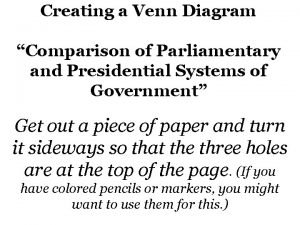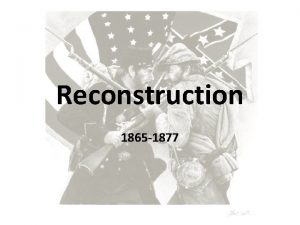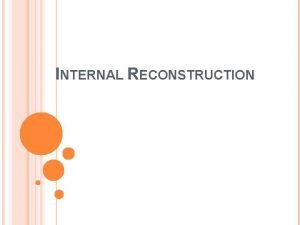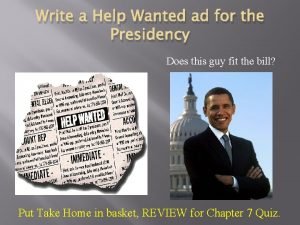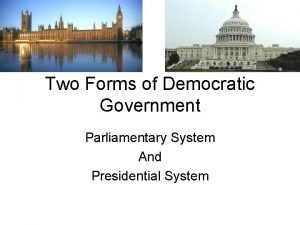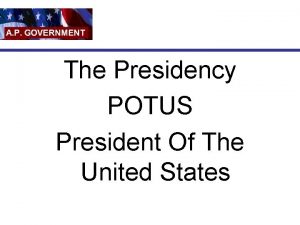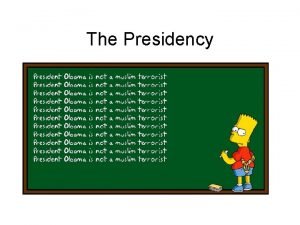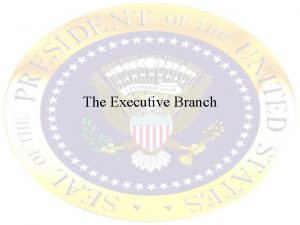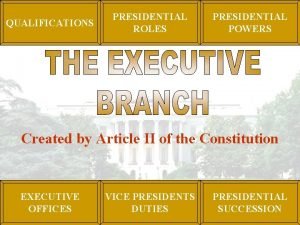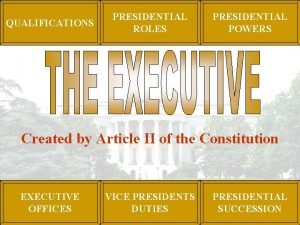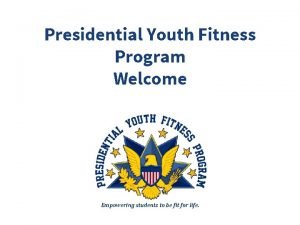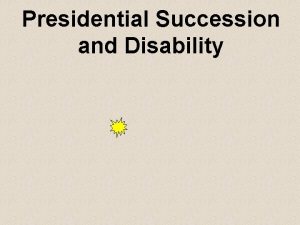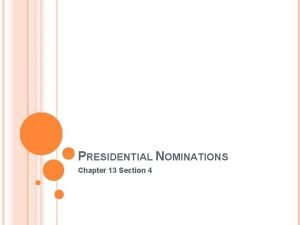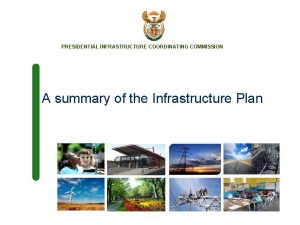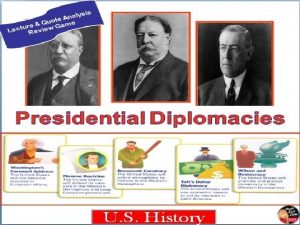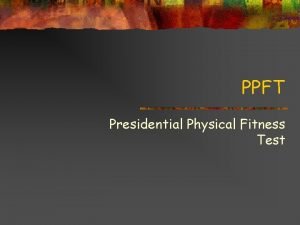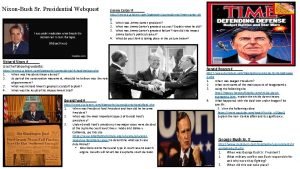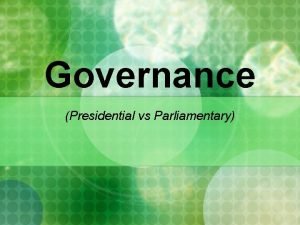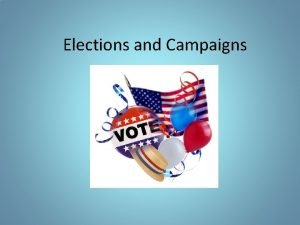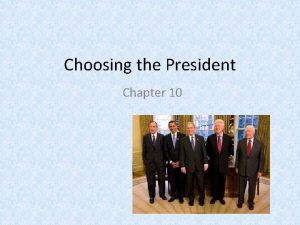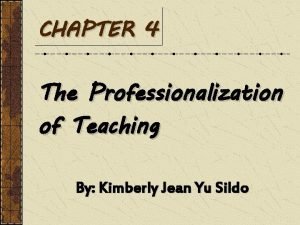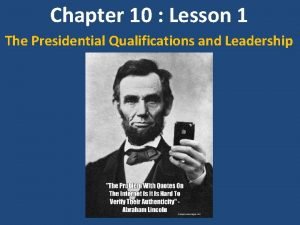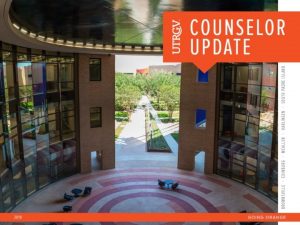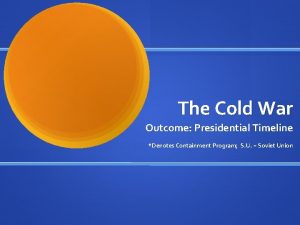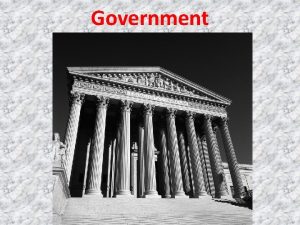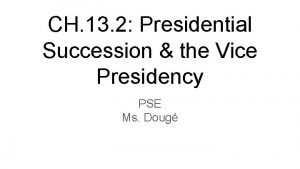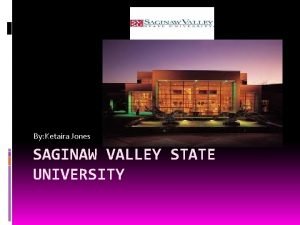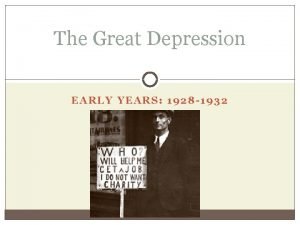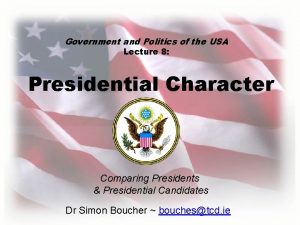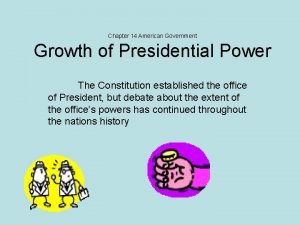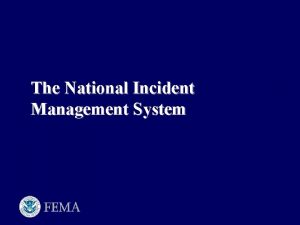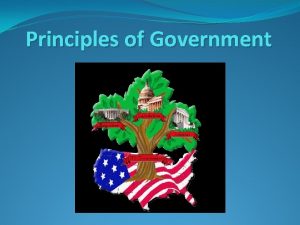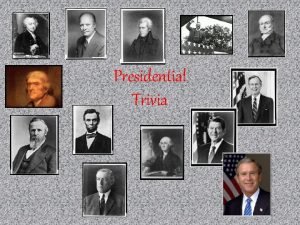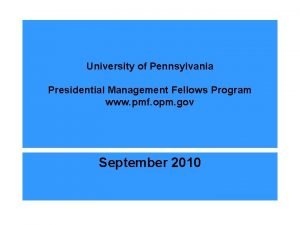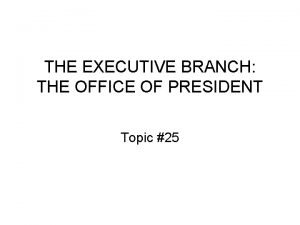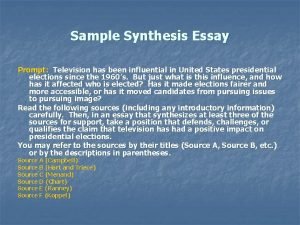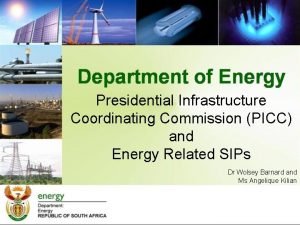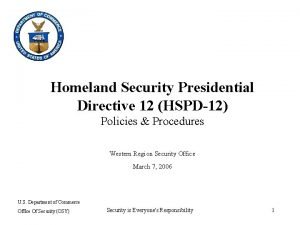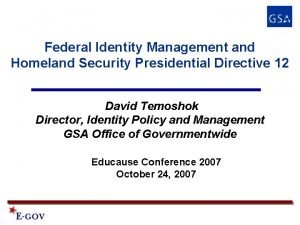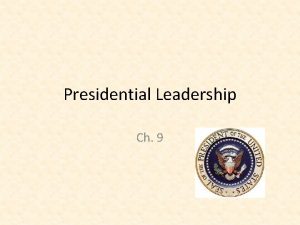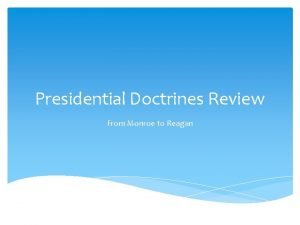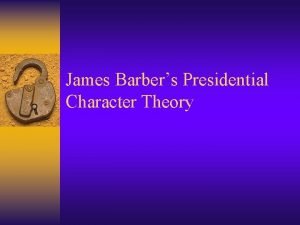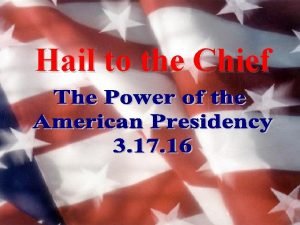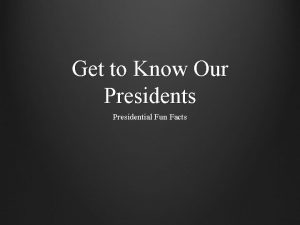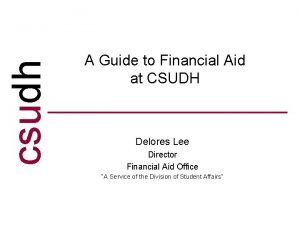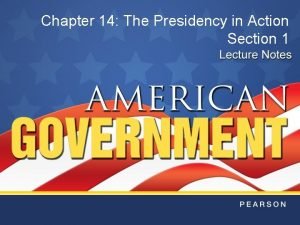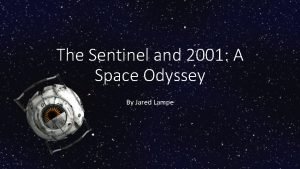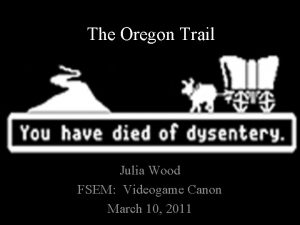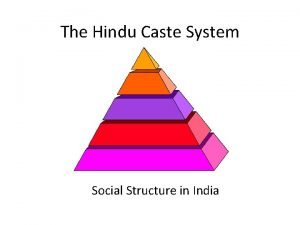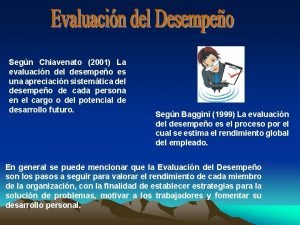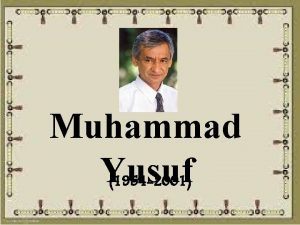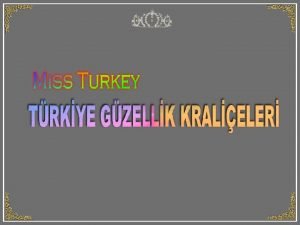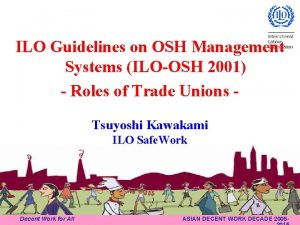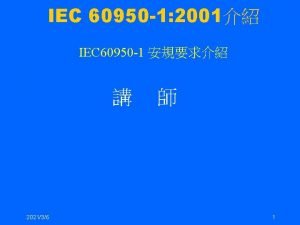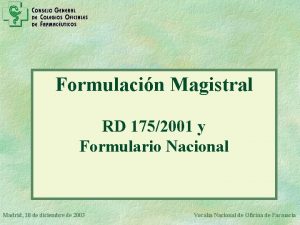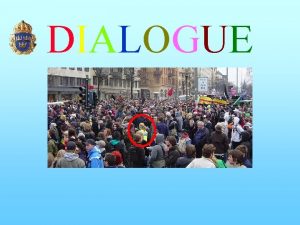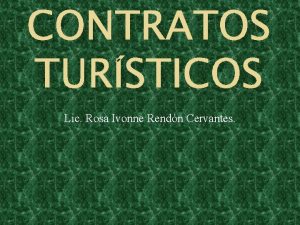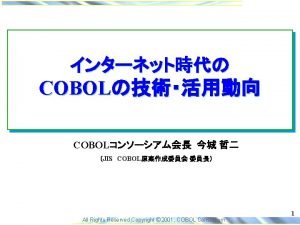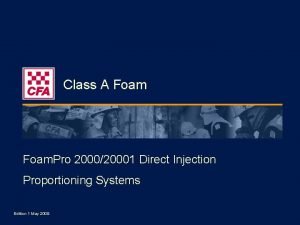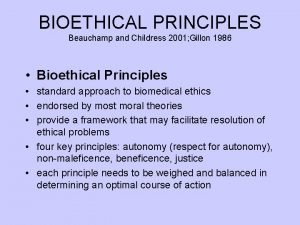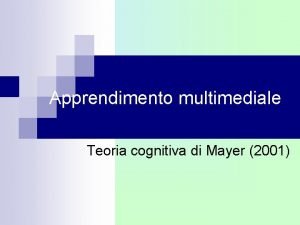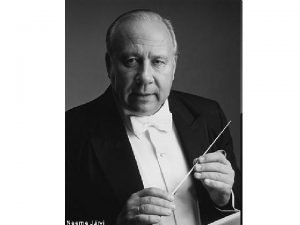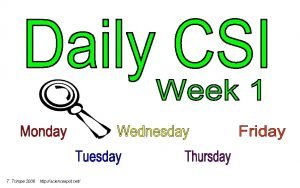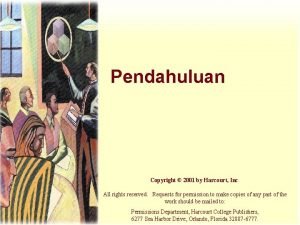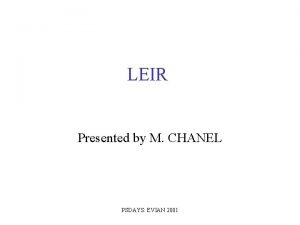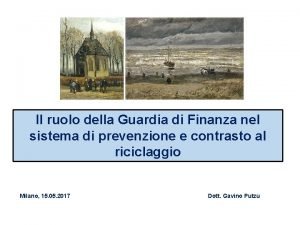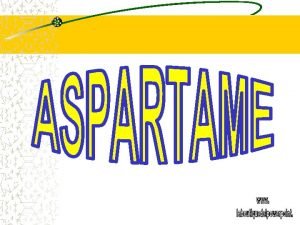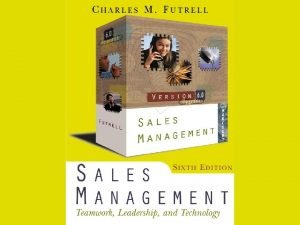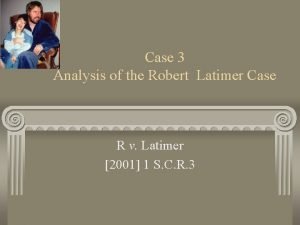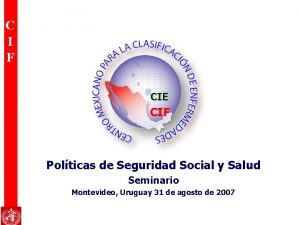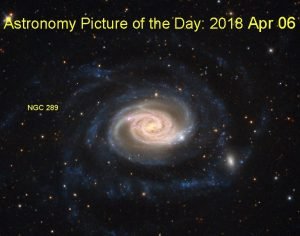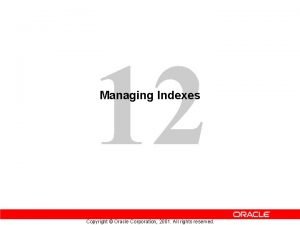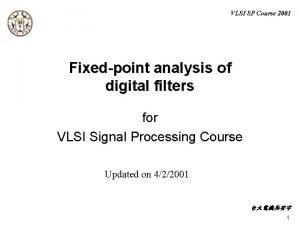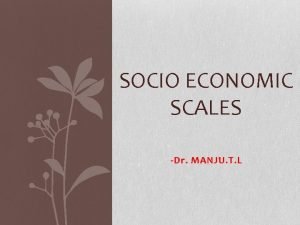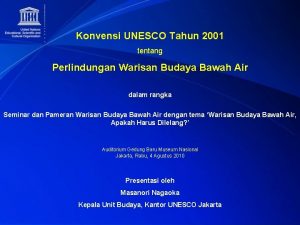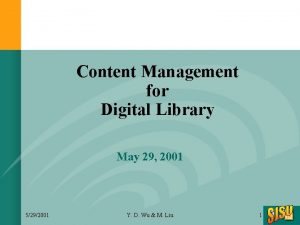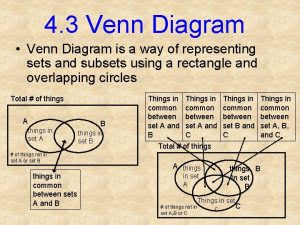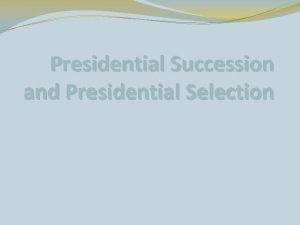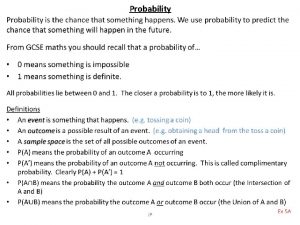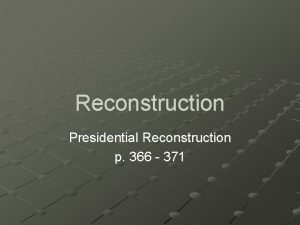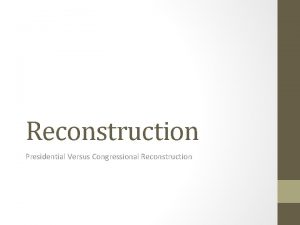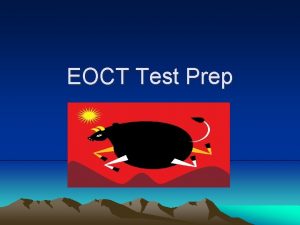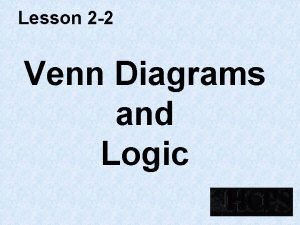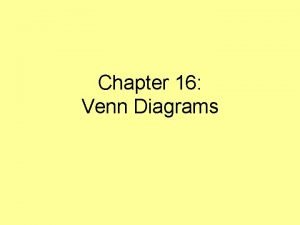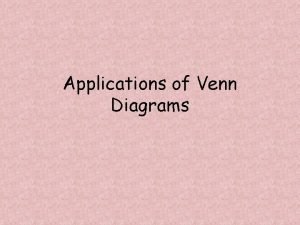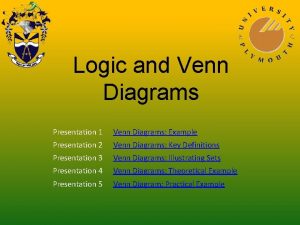EOCT Review Reconstruction 2001 Reconstruction Venn Diagram Presidential





















































































































- Slides: 117

EOCT Review Reconstruction - 2001

Reconstruction Venn Diagram Presidential Reconstruction (Lincoln & Johnson) Congressional Reconstruction (Radical Republicans) 10% Plan Pardoned Confederates No guarantee of political or social equality 13 th amendment New state constitutions Divided into 5 military districts Union Generals in charge Required to ratify 14 th amendment (citizenship)

Freedmen’s Bureau � Radical Republican plan supported by Lincoln � Created by Congress in 1865 � Goals: ◦ Provided necessities & education for black & white refugees in the South ◦ helped reunite families separated by slavery & war ◦ negotiated fair labor contracts between former slaves & white landowners

Reconstruction Amendments (1865) Thirteenth - FREE (1868) Fourteenth - CITIZENS (1870) Fifteenth - VOTE

Black Codes � issued states by all southern � laws that tried to limit rights of African Americans & keep them as landless workers � African Americans could only work in a limited number of occupations: servants or farm laborers Black Code Examples -Generally, black people could not gather after sunset. -Freedmen convicted of vagrancy (not having a job) could be fined, whipped, or sold for a year’s labor. -Freedmen had to sign agreements in January for a year of work. Those who quit in the middle of a contract often lost all that wages they had earned. -Mothers who wanted to stay home and care for their families were forced instead to do farm labor. - Freed people could rent land or homes only in rural areas.

Ku Klux Klan � Formed in Tennessee in 1866 � Burned homes, schools, and churches, and beat, maimed, or killed African Americans and their white allies � Dressed in white robes and hoods � Goals: scare freed people from voting

Johnson’s Impeachment � � To limit the Pres. ’s power, Congress passed Tenure of Office Act – Pres. needed Senate approval to remove certain officials from office Johnson tried to fire Sec. of War Edwin Stanton (Radical Republican) House of Reps voted to impeach Johnson (charge him with wrongdoing in office) Trial in Senate – failed and Johnson stayed President by only one vote

Compromise of 1877 � 1876 election: ◦ Republican Rutherford B. Hayes ◦ Democrat Samuel Tilden ◦ Tilden won popular vote & Southern states; in recount Hayes won by 1 electoral vote � Compromise of 1877 ◦ Hayes elected President ◦ In return, the remaining troops were removed from South = End of Reconstruction

Expansion of Railroads 1 st transcontinental RR completed in 1869 ◦ Union Pacific – built from E to W (used many Irish laborers) ◦ Central Pacific – built from W to E (used many Chinese laborers) ◦ Met at Promontory Pt, Utah in 1869

Rockefeller & Standard Oil: Rise of Trusts & Monopolies � John D. Rockefeller Standard Oil Company tycoon � corporations wanted to increase profits: ◦ tried to gain a monopoly – complete control over a product or service ◦ created trusts – group of separate companies that are put under the management of a single group (forms a monopoly)

Edison’s New Inventions � Thomas Edison’s Inventions: ◦ Electric light bulb (1880) ◦ Motion pictures (1888) - built the machine needed for filming and projecting motion pictures ◦ Phonograph (1877) – early record player

Who came to America? “Old” Immigrants � before Civil War (1820 - 60) � from Northern & Western Europe � mostly skilled workers � most moved onto small towns & farms of North and West � language, customs, religion similar to Americans � faced hostility, but more easily assimilated into American society “New” Immigrants � after � from Civil War (1880 -1914) Eastern & Southern Europe & Asia � mostly unskilled workers � most remained in cities of Northeast – “ethnic islands” � language, customs, religion, appearance different to Americans � faced hostility and suspicion; not easily assimilated

What were the major points of entry for immigrants coming to the United States? � 1892 Ellis Island opened in New York Harbor as major immigration station on East coast Ellis Island � 1910 Angel Island opened in San Francisco & became a major station on West coast Angel Island

The Rise of Organized Labor Union Membership Who joined? American Federation of Labor (1886) Members: only skilled workers; did NOT accept women and blacks Founder/Leaders/ Objectives/Demands Samuel Gompers Founder: Objectives: improve wages, hours and working conditions; workplaces only hire union members Significant activities/success/ failures Success: • 1890 -1915 wages rose & average workweek declined • has survived to present day – merged with CIO in 1955

Native American Conflicts: Wounded Knee � Wounded Knee (1890) ◦ U. S. government concerned, ordered arrest of Sitting Bull – he & others were killed when followers tried to rescue him ◦ U. S. troops followed Sioux who escaped – killed more than 100 at Wounded Knee, South Dakota ◦ end of Plains Indian resistance

Industrial Unrest: Pullman Strike 1894 Pullman Strike ◦ Pullman Palace Car Company laid off workers and reduced wages, later shut down plant ◦ Owner: George Pullman ◦ A. R. U. called for a nationwide strike ◦ Halted railroad traffic & mail delivery ◦ President Grover Cleveland sent federal troops to end strike ◦ Debs put in prison (he violated Sherman Antitrust Act)

Who were the muckrakers? � journalists and writers � investigated & alerted public to wrongdoing in politics & business, raised social issues Jacob Riis � Examples: Tarbell – A History of the Standard Oil Trust (monopolies & trusts) � Ida Tarbell

Upton Sinclair’s The Jungle � published 1906 � exposed dangerous and unsanitary conditions in Chicago’s stockyards � President Roosevelt read it & got Congress to pass the Meat Inspection Act – provided federal agents to inspect meat sold across state lines & required federal inspection of meat-processing plants

Jane Addams & settlement houses: � opened Hull House, a settlement house in Chicago � settlement houses – community centers organized to provide social services to the urban poor � examples of services provided: gave mothers child care classes, taught English, ran nursery schools and kindergartens, etc.

Jim Crow Laws � Segregation laws enacted in the South after Reconstruction � Plessy v. Ferguson (1896) – upheld the constitutionality of Jim Crow laws; “separate but equal” did not violate Fourteenth Amendment

NAACP � National Association for the Advancement of Colored People formed in 1909 � interracial organization founded to abolish segregation & discrimination and to achieve political & civil rights for African Americans � strategy: use courts to challenge unfair laws

Progressive Political Reforms � Initiative – citizens put a proposed new law directly on the ballot � Recall – voters can remove elected officials form office before their terms end � Referendum – process that allows citizens to approve or reject a law passed by a legislature � 17 th Amendment – direct election of Senators by voters, not state legislatures

Roosevelt & the Conservation Movement �Congress created U. S. Forest Service �Set aside 200 mill. acres of land for nat’l forests & water projects �National Reclamation Act passed (1902): set aside $ from sale of public lands to fund construction of irrigation systems in states President Roosevelt and conservationist John Muir at California’s Yosemite National Park in 1903.

Chinese Exclusion Act � 1882 ◦ ◦ Chinese Exclusion Act – 1 st immigration restriction in U. S. history prohibited immigration by Chinese laborers limited civil rights of Chinese immigrants in U. S. forbade the naturalization of Chinese residents

Causes of the Spanish-American War � � People of Cuba & Philippines wanted to rebel against Spain Depression of 1890 in Cuba; 1895 Cubans revolted against Spain Spanish used harsh tactics against Cubans (Gen. Valeriano “the Butcher” Weyler) American press (“yellow journalism”) reported cruelties; Pulitzer & Hearst created sympathy for Cubans “The Butcher” Weyler Joseph Pulitzer, � American investments & property journalist destroyed during Cuban revolt for New York World

Causes lead to Spanish-American War � � Feb 9, 1898 – De. Lome Letter printed in Hearst’s Journal – called Mc. Kinley weak & stupid Feb 15, 1898 – USS Maine exploded in Havana harbor killing 266 American sailors; press blamed Spain - “War? Sure!” Mc. Kinley asked Congress to declare war April 19, Congress declared war & adopted Teller Amendment – US had no intention of annexing Cuba

Effects of the Spanish-American War: Philippine-American War � U. S. annexation of Philippines led to Philippine-American War � led by Emilio Aguinaldo � 3 years; 216, 000 Filipinos died & 5, 000 Americans � 1946 - Philippines given independence

Debate over Expansion Imperialists supported expansion Arguments: 1. 2. 3. 4. 5. 6. Americans needed new frontier New markets for American manufactured goods New sources of raw materials Increase in military power Spread American ideals: Christianity, democracy, capitalism American superiority – our “duty”

Debate Over Expansion Anti-imperialists opposed expansion Arguments: 1. 2. 3. 4. 5. 6. Rejected nation’s foundation of “liberty for all” Faced enough difficulties at home Threatened democratic foundations (fear of large standing armies) Racism – might have to absorb people of different races Expansion would cost too much Fear of competition in job market; lower wages

Review: What is the Monroe Doctrine? �Issued by President Monroe in 1823 �We (United States) won’t bother you (Europe), you don’t bother us (Western Hemisphere)

Roosevelt Corollary (To Monroe Doctrine) � Why? Europeans threatened intervention in W. Hemisphere (to collect debts, etc. ) � When and how stated? In Dec. 1904 by Roosevelt in message to Congress � Central Message: if intervention in W. Hemisphere necessary, U. S. would intervene, not European nations

How Did U. S. Acquire Rights to Build the Canal? � Hay-Bunau-Varilla Treaty signed w/ Panama in 1904 � Panama Canal Timeline: 1) 1903: U. S. negotiated treaty w/ Colombia (Panama part of) 2) Colombian gov’t stalled treaty demanding more money 3) Roosevelt impatient – supported Panama’s revolt 4) U. S. recognized Panama’s independence, negotiated treaty w/ Panama ($10 mill; $250, 000 yearly lease for 10 mile wide strip)

American Enters WWI: British passenger liner Lusitania 128 Americans died

American Enters WWI: French passenger ship Sussex & Sussex pledge

American Enters WWI: Zimmerman Telegram German Foreign Minister Arthur Zimmerman Telegram sent to Mexico asking Mexico to declare war on the U. S.

America enters WWI: Zimmerman Telegram �German foreign minister Arthur Zimmerman sent telegram to Mexico with this proposal: ◦ Mexico should declare war on the U. S. if they declare war on Germany ◦ In return, if Germany won war, they would give Mexico back Texas, New Mexico, and Arizona (lands lost in Mexican-American War) ◦ Mexico declined the proposal, but when Germany again announced unrestricted submarine warfare against Great Britain, the U. S. declared war on Germany on April 6, 1917

WWI Home Front � � � Selective Service Act – ◦ passed by Congress in 1917; authorized draft of men for military service; 2. 8 million drafted, 4. 8 million served Women – ◦ won right to vote; moved into the workforce to replace men who were fighting; served as nurses Government Responses to Opposition: ◦ Espionage Act (1917) - severe penalties for anyone involved in disloyal or treasonable activities or interfering with the war effort ◦ Sedition Act (1918) – illegal to use disloyal or abusive language about American government, Constitution, or military; Socialist leader Eugene V. Debs (ARU) imprisoned for anti-war speech

Woodrow Wilson’s Fourteen Points � Fourteen Points - Wilson’s list of terms for resolving WWI and future wars � Key ◦ ◦ ◦ ideas: “peace without victory” open diplomacy freedom of seas and free trade move toward ending colonialism self-determination League of Nations

America Rejects the Treaty � Senate’s issues with the Treaty of Versailles: ◦ concerned about the League of Nations ◦ afraid the treaty could lead the U. S. into a war without the consent of Congress � The United States did NOT ratify the treaty to join the League of Nations. � U. S. foreign policy after rejecting the treaty – isolationism

Prohibition – Eighteenth Amendment �Prohibition – the banning of alcoholic beverages � 1919 states ratified Eighteenth Amendment – forbade the manufacture, distribution & sale of alcohol in the U. S.

Nineteenth Amendment • Approved by Congress in 1919 • Gave women the right to vote

The Red Scare � Red Scare – fear of communists & radicals thought to be planning revolution in U. S. � Attorney General A. Mitchell Palmer led raids against suspected radicals & foreigners using Espionage & Sedition Acts � Palmer General A. Mitchell Palmer – leader of the Palmer Raids & agents accused of using torture to obtain intelligence & collect evidence

Henry Ford’s Model T Henry Ford: responsible for much of America’s economic growth 1908 Model T – made cars affordable for ordinary Americans by: ◦ Mass production – used on a larger scale (thousands of parts) ◦ Assembly Lines – opened large factories (esp. in Detroit) and put cars on moving belts; workers added interchangeable parts; reduced manufacture time from 12 hours to 90 minutes

Radio � 1920 s radios became widespread � news & entertainment broadcasts began � increased the speed with which people gained information � increased unity national

Movies � 1920 s movies became popular � 1927 the first movie with sound, The Jazz Singer �movies with sounds called “talkies”

The Harlem Renaissance is Latin for “rebirth” What was the Harlem Renaissance ? American period of “rebirth” for African culture During this period, African American novelists, poets, and artists celebrated their culture

Louis Armstrong � trumpet player – famous for jazz music � nicknamed “Satchmo” � known as the “ambassador of jazz” – traveled to Africa, Asia, & Europe � also pioneered “scat”

Irving Berlin � songwriter � inspired � songs & composer by jazz music written by Berlin: ◦ “God Bless America” ◦ “Blue Skies” ◦ “I’ve Got My Love to Keep Me Warm” ◦ “White Christmas” ◦ “Happy Holiday”

Tin Pan Alley � collection of New York City music publishers & songwriters that dominated popular music � composers like Irving Berlin � commercialization of music --jazz and blues pop-songs & dance numbers popularized � sheet music manufactured for commercial sale & profit Buildings housed sheetmusic publishers that were the center of American popular music in early 1900 s.

Causes of the Depression Overproduction Under Consumption Stock Market Speculation The Great Depression

The Dust Bowl – central & southern Great Plains during 1930 s when region suffered dust storms Causes: 1. Severe drought 2. Over farming - farmers 3. High winds - layers of top plowed the plains & eliminated protective layer of grass soil blown away, leaving dunes of grit & sand

Impact on Americans �Unemployment soared – 25 -30% of work force �Bank failures – ¼ of nation’s banks �Business failures – 85, 000 �Homelessness, hunger widespread ◦ fed in breadlines, received assistance from charities ◦ evicted from homes & formed Hoovervilles – makeshift shantytowns of tents & shacks built on public land or vacant lots �Farm foreclosures

The Dust Bowl Areas Affected: ◦ Great Plains Results: ◦ Dust storms caused people to leave ◦ Dust Bowl refugees known as “Okies” ◦ Results of the migration: rural states lost population, large cities gained more people

New Deal: TVA (1933) � Name: Tennessee Valley Authority � Description: ◦ built dams on TN River to provide hydroelectric power, flood control, & prevent soil erosion ◦ created jobs & provided cheap electricity for rural areas ◦ still functioning today

SSA (1935) � � Name: Social Security Act Description: ◦ provide security in the form of regular payments to people who could not support themselves ◦ funded by payroll tax ◦ 3 types of payments: 1. old-age pensions 2. unemployment insurance 3. aid for dependent children & disabled

Wagner Act (1935) � guaranteed unions collective bargaining rights � outlawed discrimination against workers due to union membership/activities � set up NLRB to enforce law’s provisions

FDR & Eleanor � FDR depended on Eleanor � She traveled & interacted w/ American people serving as FDR’s “eyes & ears” � 1933 Bonus Army incident; FDR sends Eleanor instead of army

Eleanor � offered advice on policy issues � advocated public health & education, promoted arts, addressed flood control � gave money she earned to charity Eleanor changed the office of First Lady from a ceremonial role to a position of action & involvement.

Challenges to Roosevelt’s “New Deal” � LA Senator Huey P. Long criticized New Deal wanted more help for poor � proposed “Share Our Wealth” program - high taxes on wealthy & large corporations; redistribute their income to poor � made enemies because he ruled state of LA like he owned it – 1935 political enemy assassinated him

FDR’s “Court Packing Bill” � Supreme Court challenges the New Deal: FDR upset by Supreme Court striking down New Deal programs (AAA) � Roosevelt proposes “packing the court”: asked Congress to increase size of Supreme Court (6 more members) – why? stated reason: many justices elderly & overworked; relieve the burden on them unstated reason: app’t more liberal justices who would support the New Deal & sway court in FDR’s favor

Reaction to FDR’s Plan � Critics react to Roosevelt’s plan: negative public reaction; bill did not pass Accused FDR of trying to increase Pres power & upset balance (separation) of powers � FDR is weakened politically: FDR lost political support; public less willing to accept new programs In long run, Court became more accepting of New Deal

United States’ Action during WWII � majority of Americans opposed U. S. intervention � Congress passed the Neutrality Acts of 1935, 1936, and 1937 – imposed restrictions on Americans during times of war example: prohibited sailing on ships owned by nations at war, prevented Americans from making loans to nations at war or selling them weapons

Another Neutrality Act � Roosevelt declared American neutrality but was anti-Nazi � convinced Congress to pass the Neutrality Acts of 1939 – included a cash-and-carry provision – nations at war could buy goods & arms in the U. S. if they paid cash & carried merchandise on their ships

African Americans Gain Civil Rights � Double “V” campaign: need for victory against dictators abroad & discrimination in U. S. � A. Philip Randolph: organized protest march on Washington, D. C. & convinced FDR to issue Executive Order 8802 – assured fair hiring practices in jobs funded w/ gov’t money & est. Fair Employment Practices Committee

Japan Attacks Pearl Harbor � Dec. 7, 1941, Japanese planes attacked Pearl Harbor in the Hawaiian Islands. � Dropped bombs on American ships at naval base. � in less than two hours, Japan destroyed most of the U. S. Pacific fleet. � more than 2, 000 sailors & 68 civilians killed

Challenges to Civil Liberties � Roosevelt ordered 110, 000 Japanese Americans into “relocation camps” – internment �Moved to Utah, California, Arizona, Wyoming, Arkansas, & Idaho �Had to sell homes, businesses, & belongings � Over 17, 000 Japanese Americans served in Army units even while friends & families were in camps � Korematsu v. U. S. decision upheld internment

Roosevelt Inches Toward Involvement � 1941, Congress passed Lend-Lease Act � allowed Roosevelt to sell or lend war supplies to any country whose defense he considered vital to U. S. safety

WWII: Battle of Midway � Midway Date: 1942 Description: Japan (under Admiral Yamamoto) attempted to destroy American aircraft carriers in Pacific; Navy code breakers intercepted message & under U. S Admiral Chester Nimitz’s leadership U. S defeated Japan; * turning point of the war in the Pacific – stopped Japan’s advance

WWII: D-Day � Operation Overlord (D-Day) Date: June 6, 1944 Description: the Allies led by Gen. Dwight D. Eisenhower landed on the beaches of Normandy, France; high American causality rates at Omaha beach; *Allies successful at gaining ground in France

World War II Allied Conferences Potsdam (July ‘ 45) � Leaders: Harry S. Truman (U. S. ), Clement Atlee (Britain), Stalin (Soviet Union) � Decisions Reached: decided to divide Germany into four zones of occupation: Soviet, American, British, & French; free elections for Poland; Soviets’ right to claim reparations for war damages from Germany

Potsdam: Division of Germany

Supporting War Effort � Cost of WWII: $330 billion � Financed: imposed a 5% tax on working Americas; Americans bought war bonds � Rationing: Americans were issued coupon books that limited the amount of certain goods they could buy

Women Work for Victory � Women’s contribution to the war: worked in heavy industry, need for workers ended common practice of women quitting their jobs once married “Rosie the Riveter”

The Manhattan Project � Manhattan Project – code-name � Project leaders: General Leslie Groves & physicist J. Robert Oppenheimer � Los Alamos, New Mexico � Truman made decision to drop 2 atomic bombs on Japan to save American lives

1947: Truman Doctrine announced �Truman Doctrine – Truman promised to aid nations struggling against communist movements

1948: Marshall Plan authorized �Sec. of State George Marshall’s plan to help Europe recover from war �Marshall Plan – economic aid for nations in Western Europe - U. S. gave money (grants & loans), food, fuel

1947: Kennan outlines Containment Policy � Kennan – American diplomat & authority on Soviet Union � Containment policy – keep communism contained within its existing borders; became America’s policy

1949: People’s Republic of China proclaimed � Mao Zedong led communist forces in China against Nationalist leader Chiang Kai -shek � Mao defeated nationalist forces & renamed China People’s Republic of China – communist nation � Truman Adm. blamed for not providing enough support Mao Zedong

1950: Korean War begins � Korea – split at 38 th parallel; North was communist, South noncommunist � N. Korea attacked S. Korea & took S. Korea’s capital, Seoul � UN Security Council voted to aid S. Korea; Truman ordered U. S. troops to S. Korea

1953: Korean War ends �stalemate until 1953 �Eisenhower elected U. S. President – promised to end war �cease-fire signed, division at 38 th parallel restored – still in effect today

1950: Another Red Scare Mc. Carthyism � Senator Joseph Mc. Carthy claimed State Department was full of communists � Mc. Carthyism – extreme, reckless charges of disloyalty; discredited real concerns about communists in the U. S. � Red Scare declined by 1954

1961: Bay of Pigs invasion � 1959 Fidel Castro set up a communist gov’t in Cuba � Eisenhower had approved CIA plan to invade Cuba & overthrow Castro; recruited Cuban exiles & trained in Guatemala � Kennedy executed plan – CIAled force of Cuban exiles attacked Cuba � plan failed & many turned Cuban Americans against Kennedy

1962: Cuban Missile Crisis � U. S. discovered Soviets building nuclear missile sites in Cuba to protect Castro from an American invasion � major East Coast cities would be in range � Kennedy demanded removal of missiles & set up blockade of Cuba to prevent Soviets from completing bases � Khrushchev removed missiles Range of Cuban missiles

1968: Vietnam War – Tet Offensive � Tet Offensive – Vietcong’s coordinated attack on S. Vietnam; 36 provincial capitals, 5 major cities, & U. S. embassy in Saigon � American & S. Vietnamese forces stopped offensive, but demonstrated communists had not lost will or ability to fight � President Johnson announced plan to pursue peace, not victory; would not run for a second term

Baby Boom � increase in births between 1945 – 1964 � families had put off having families during depression & war, but started having children when soldiers returned after WWII

Levittown � William Levitt – mass produced suburban homes � Levittown – New York suburb that offered affordable homes ($8, 000 each); demand increased & other Levittown's built

Interstate Highway Act Eisenhower’s Interstate Highway Act – authorized spending $32 billion to build 41, 000 mi. of highway

Election of 1960 � Kennedy (R) (D) v. Nixon � his Catholicism worked against him � first televised Presidential debates – benefited Kennedy & probably swayed election in his favor

1957: Sputnik launched by Soviets & U. S. reaction � Sputnik satellite � U. S. I - Soviet space reaction ◦ Congress approved the National Defense Education Act - $1 billion program to produce more scientists and teachers of science ◦ Congress created National Aeronautics and Space Administration (NASA) to plan space-related projects

Truman’s desegregation of the military � Date: 1948 � Description: ◦ Background: Truman appt. Committee on Civil Rights to investigate race relations; Truman attempted to implement suggestions, but Congress did not support ◦ Truman used executive power to order the desegregation of military

Jackie Robinson breaks the color line �Date: 1947 �Description: Jackie Robinson joined the Brooklyn Dodgers becoming the first African American to play baseball in the major leagues

Brown v. Board of Education of Topeka, KS � Date: 1954 � Description: overturned the “separate but equal” principle established by 1896 Plessey v. Ferguson case; U. S. Supreme Court decided segregated public education violated the U. S. Constitution

King’s arrest & Letter from a Jail �Date: 1963 �Description: King joined protesters in Birmingham and was arrested; from jail he wrote a letter explaining why civil rights activists were tired of waiting for change Birmingham

March on Washington & “I Have a Dream” Speech � Date: 1963 � Description: organized by NAACP, SCLC, & SNCC; 200, 000 demonstrators marched on capital to put pressure on Congress to pass a new civil rights bill � King gave his “I Have a Dream” speech in front of the Lincoln Memorial

Civil Rights Act of 1964 Description: signed by Pres. Johnson (Kennedy assassinated Nov. 1963) � banned segregation in public accommodations � gave federal gov’t ability to make state & local boards desegregate their schools � allowed Justice Dept. to prosecute individuals who violated people’s civil rights � outlawed discrimination in employment – est. Equal Employment Opportunity Commission

Voting Rights Act of 1965 �Description: banned literacy tests & gave the federal gov’t the power to oversee voting registration & elections in states that had discriminated against minorities

Warren Court � Chief Justice of Supreme Court - Earl Warren � nominated by Eisenhower � liberal rulings- helped expand individual rights � Brown v. Board of Ed. (’ 54) � Miranda v. Arizona (‘ 66) ◦ Miranda Rights – accused criminals had to be informed of his/her Fifth (remaining silent) & Sixth Amendment rights (speed, public trial before jury) before being questioned

Johnson’s Domestic Highlights �“Great Society” – focused on health care, education, environment, discrimination, & poverty ◦ Medicare (hospital insurance for people over 65) ◦ Medicaid (low-cost health insurance for poor)

�Date: 1968 �Description: Martin Luther King’s assassination assassinated in Memphis, TN on April 4 th while on the balcony outside his motel room; James Earl Ray, a white ex-convict was charged with the murder

Robert Kennedy: Assassination � Robert Kennedy (RFK): ◦ ◦ ◦ � JFK’s little brother politician & U. S. Attorney General civil rights activist – Civil Rights Bill opposed Vietnam War 1968 Presidential Candidate Assassination ◦ shot June 5, ‘ 68 (2 mo. after MLK) by Sirhan, Palestinian immigrant � Democratic Nat’l Convention in Chicago (‘ 68) – debate Vietnam ◦ Antiwar protesters are beaten by Police outside convention center

Formation of SCLC �Date: 1957 �Description: After Montgomery Bus Boycott, King & minister Ralph Abernathy est. Southern Christian Leadership Conference (SCLC) to fight for civil rights �Membership: mostly southern African American ministers �promoted nonviolent resistance

Formation of SNCC � Date: 1960 � Description: Ella Baker, granddaughter of slaves, helped young civil rights activists form the Student Nonviolent Coordinating Committee (SNCC) � Goal: create grass-roots (community) movement that involved all classes of African Americans in pursuing equality

Women’s Rights Movement 1960 s & ‘ 70 s � feminism – political, social, & economic equality of men & women � Origins: began 1840 s – Declaration of Sentiments, 1 st feminism wave in ‘ 20 s Betty Friedan Nineteenth Amendment The Feminine Mystique � Nat’l Organization of Women ◦ Goals: pass Equal Rights Amend. to guarantee gender equality; protect reproductive rights � Roe v. Wade (‘ 73) – right to legal abortions in first 3 mo. of pregnancy Gloria Steinem

Cesar Chavez & United Farm Workers’ movement � Chavez – migrant farmworker & Latino activist, fought for rights for farm laborers (often exploited) – better working conditions � United Farm Workers – used nonviolent tactics; started worker’s strike & consumer boycott of grapes successful – ’ 75 CA passed law requiring collective bargaining between growers & union reps.

Environmental Movement � Rachel Carson – biologist, wrote Silent Spring (‘ 62) – described deadly impact pesticides were having on birds & other animals; Congress restricted use of pesticide DDT (eagles) � Earth Day – April 22, ‘ 70 nationwide protest org. by WI senator Gaylord Nelson; 20 million Americans participated � EPA – gov’t agency created by Congress in ’ 70 to clean up & protect the environment

Election of 1964 � L. Johnson (D) v. Goldwater (R) � did not seek reelection in ‘ 68 due to divisions over Vietnam � Goldwater marks rise of the Conservative movement

1972: Nixon visits China � After Chinese communist revolution, U. S. never formally recognized People’s Rep. of China; Nixon wanted to - benefit U. S. economically (trade) & distance relationship b/w China & Soviet Union � Nixon made an official state visit to China – successful at opening relations w/ China � full Diplomatic relations established b/w U. S. & China in 1979 President Nixon meets with China’s Communist Party leader, Mao Zedong

Nixon & Watergate � Watergate Scandal ◦ attempted break-in of Dem. Party headquarters (Watergate complex) ◦ connected to Nixon ◦ reelection committee tried to bug office & record conversations of political opponents � Nixon resigned in 1974; Ford became President and pardoned Nixon

Affirmative Action � affirmative action – policy that gives special consideration to women & minorities to make up for past discrimination; ’ 70 s - special focus on employers & schools � Bakke decision: ◦ Regents of the University of California v. Bakke (‘ 78) ◦ Medical school reserved spots in class for minorities ◦ Bakke (white, stronger academic record) not accepted & claimed racial discrimination ◦ Supreme Court required Bakke’s admission but did not overturn affirmative action

Carter’s Foreign Highlights � Camp David Accords (’ 78) - peace treaty between Egypt & Israel, Egypt recognized nation of Israel & Israel withdrew troops from Sinai Peninsula � Iranian Revolution (‘ 79) – opposition to Shah (emperor) of Iran led to the Ayatollah Khomeini seizing power, Shah fled to U. S. for cancer treatment � Iran-Hostage Crisis (Nov ’ 79 -Jan ’ 81) – Iranian radicals responded by invading U. S. embassy & taking 66 Americans hostage, held for more than a year before being released – after Reagan’s election

Reagan’s Domestic Highlights � “Conservative Revolution” � “Reaganomics” – supply-side economics adopted – reduce taxes so people will work more, have more money to spend = economic growth

Reagan’s Foreign Highlights � Iran-Contra Scandal (’ 86) – U. S. sold weapons to Iran in ’ 85; in exchange, Iran promised to pressure terrorist groups in Lebanon to release Am. hostages – plan not successful & contradicted policy of not negotiating w/ terrorists; used money from weapon sales to fund Contras (anticommunists) in Nicaragua – previously banned by Congress

1989: Berlin Wall falls & E. European nations throw off Communism � Berlin Wall blocked travel from communist East Berlin to democratic West Berlin � 1989 – East Germany’s communist government fell; Berlin wall torn down East German Border guards demolishing a section of the Berlin Wall � Communists also lost power in Poland, Hungary, Czechoslovakia, Bulgaria, & Romania in 1989; Albania in 1990; Yugoslavia in 1991

1991: Soviet Union collapses � Communist Party lost power & Soviet Union separated into 15 independent republics � Cold War ended (1945 -1991)

Clinton’s Highlights � Free trade reappeared: ◦ NAFTA (North American Free Trade Agreement) (‘ 92) – called for the gradual removal of trade restrictions among the U. S. , Canada & Mexico � Scandals: ◦ Lewinsky – Clinton’s affair with a White House intern, lied under oath about affair � Impeached in ’ 98 - acquitted

Election of 2000 �G W Bush (R) v. Gore (D) � Disputed election in Florida (25 Electoral College votes); Bush awarded victory in FL & therefore won Electoral College majority (by 1 vote) (Gore won popular vote)

September 11, 2001 � Terrorist attack by Osama bin Laden’s al Qaeda network � More than 3, 000 Americans died � Bush declares “war on terrorism” � American intervention: ◦ Afghanistan: Bin Laden believed to be hiding in Afghanistan where Taliban government let them run terrorist training camps; U. S. overthrew Taliban gov’t; held free elections & wrote a new constitution ◦ Iraq: believed Saddam Hussein was building & stockpiling Weapons of Mass Destruction (WMD); 2003 Operation Iraqi Freedom – U. S. forces invade; 2005 Iraq wrote new constitution
 Eoct review by standard sps1 answer key
Eoct review by standard sps1 answer key Reconstruction venn diagram
Reconstruction venn diagram Presidential and radical reconstruction venn diagram
Presidential and radical reconstruction venn diagram Presidential and congressional reconstruction venn diagram
Presidential and congressional reconstruction venn diagram What does reconstruct mean
What does reconstruct mean Presidential and congressional reconstruction venn diagram
Presidential and congressional reconstruction venn diagram Venn diagram of presidential and parliamentary democracy
Venn diagram of presidential and parliamentary democracy Presidential reconstruction
Presidential reconstruction Traditional and systematic review venn diagram
Traditional and systematic review venn diagram Internal reconstruction
Internal reconstruction Chapter review motion part a vocabulary review answer key
Chapter review motion part a vocabulary review answer key Ap gov review final exam review
Ap gov review final exam review Narrative review vs systematic review
Narrative review vs systematic review Narrative review vs systematic review
Narrative review vs systematic review President as chief administrator
President as chief administrator Presidential form of government
Presidential form of government Unitary state
Unitary state Presidency line of succession
Presidency line of succession Informal presidential powers
Informal presidential powers Informal presidential power
Informal presidential power Presidential roles
Presidential roles Presidential roles
Presidential roles Presidential youth fitness program
Presidential youth fitness program Presidential succession
Presidential succession Presidential succession act of 1947 definition
Presidential succession act of 1947 definition Chapter 13 section 4 presidential nominations
Chapter 13 section 4 presidential nominations Presidential infrastructure coordinating commission
Presidential infrastructure coordinating commission Presidential infrastructure coordinating commission
Presidential infrastructure coordinating commission Presidential diplomacies
Presidential diplomacies Ppft meaning in physical education
Ppft meaning in physical education Ronald reagan ducksters
Ronald reagan ducksters Presidential vs parliamentary
Presidential vs parliamentary Presidential elections exploration and announcement
Presidential elections exploration and announcement Presidential succession
Presidential succession Providing for the professionalization of teachers
Providing for the professionalization of teachers Guided reading activity choosing the president lesson 1
Guided reading activity choosing the president lesson 1 Dara newton utrgv
Dara newton utrgv Win the white house brainpop
Win the white house brainpop Cold war presidential timeline
Cold war presidential timeline Pngpa
Pngpa Oligarchy examples
Oligarchy examples Presidential succession definition
Presidential succession definition Fort valley state university dorm tour
Fort valley state university dorm tour 1932 presidential election
1932 presidential election 1932 presidential election
1932 presidential election Def of primary succession
Def of primary succession Presidential succession act of 1947 definition
Presidential succession act of 1947 definition Barber's typology of presidential character
Barber's typology of presidential character Chapter 14 section 1 the growth of presidential power
Chapter 14 section 1 the growth of presidential power Presidential directive 5
Presidential directive 5 Autobell scholarship
Autobell scholarship What specific trait gives the us a presidential
What specific trait gives the us a presidential President trivia questions
President trivia questions Presidential fellowship upenn
Presidential fellowship upenn Informal.powers of the president
Informal.powers of the president Presidential informal powers
Presidential informal powers Ap lang synthesis essay television presidential elections
Ap lang synthesis essay television presidential elections Presidential infrastructure coordinating commission
Presidential infrastructure coordinating commission Homeland security presidential directive 12
Homeland security presidential directive 12 David temoshok
David temoshok Apa presidential task force on evidence-based practice
Apa presidential task force on evidence-based practice Informal powers of the president
Informal powers of the president Presidential doctrines
Presidential doctrines Lehigh presidential scholarship
Lehigh presidential scholarship Barber's theory of presidential character
Barber's theory of presidential character Congress formal and informal powers
Congress formal and informal powers Tug of war
Tug of war President that got stuck in bathtub
President that got stuck in bathtub Csudh presidential scholarship
Csudh presidential scholarship Chapter 14 section 1 the growth of presidential power
Chapter 14 section 1 the growth of presidential power 1938 presidential stamps
1938 presidential stamps 2001: űrodüsszeia the sentinel
2001: űrodüsszeia the sentinel Oregon trail platforms
Oregon trail platforms India caste system
India caste system Localization of function ib psychology
Localization of function ib psychology Stuff that happened in 2001
Stuff that happened in 2001 Chiavenato 2001
Chiavenato 2001 Imagem dupla interpretação
Imagem dupla interpretação Muhammad yusuf maylida kimgadir yoqsa yoqmasa
Muhammad yusuf maylida kimgadir yoqsa yoqmasa 1979 türkiye güzeli şebnem ünal şimdiki hali
1979 türkiye güzeli şebnem ünal şimdiki hali Kasus manajemen laba
Kasus manajemen laba Ilo-osh 2001
Ilo-osh 2001 Iec 60950
Iec 60950 Rd 175 de 2001
Rd 175 de 2001 Gothenburg riots 2001
Gothenburg riots 2001 Nom 010 tur 2001
Nom 010 tur 2001 Copyright 2001
Copyright 2001 Foampro 2001
Foampro 2001 Beauchamp and childress 2001
Beauchamp and childress 2001 Mayer 2001
Mayer 2001 Ayon kay goodman ang pagbasa ay
Ayon kay goodman ang pagbasa ay V xxxxx
V xxxxx Helilooja 1949-2001
Helilooja 1949-2001 Destination imagination 2001
Destination imagination 2001 Http //sciencespot.net/
Http //sciencespot.net/ T. trimpe 2001 http://sciencespot.net/
T. trimpe 2001 http://sciencespot.net/ Samsung organization
Samsung organization Antwrp
Antwrp Copyright 2001
Copyright 2001 Robbins 2001
Robbins 2001 Evian 2001
Evian 2001 Special educational needs and disability act 2001
Special educational needs and disability act 2001 2001 july 15
2001 july 15 Dlgs 68/2001 poteri gdf
Dlgs 68/2001 poteri gdf A mi hermana (2001)
A mi hermana (2001) Copyright 2001
Copyright 2001 R v latimer summary
R v latimer summary Modelo interactivo
Modelo interactivo Astronomy picture of the day 17 april 2001
Astronomy picture of the day 17 april 2001 Bitmap index in oracle
Bitmap index in oracle 2001 course
2001 course Rumus indeks walsh
Rumus indeks walsh 2001 course
2001 course Bharadwaj scale 2001
Bharadwaj scale 2001 Konvensi unesco 2001
Konvensi unesco 2001 Destination imagination 2001
Destination imagination 2001 2001
2001 Nccpl
Nccpl
